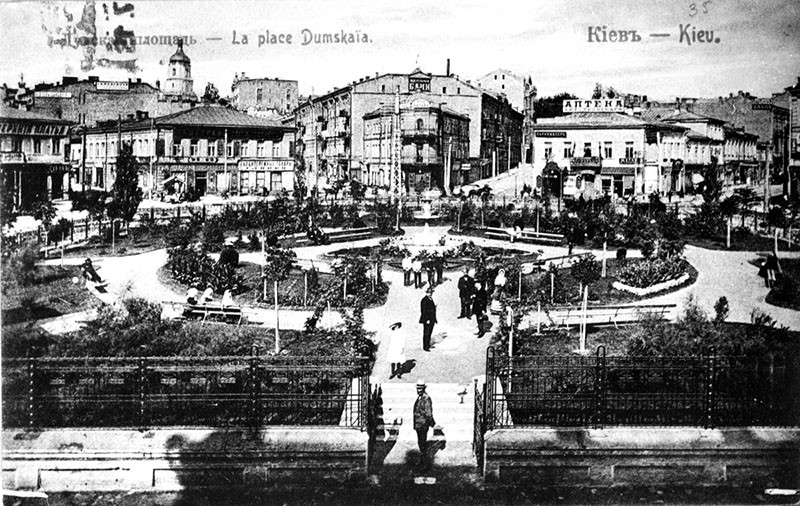Independence Square, or Maidan Nezalezhnosti, is perhaps the most familiar place in Ukraine, the scene of heroic and tragic events.
In the winter of 2013-14, it was the focal point of the EuroMaidan Revolution that ousted President Viktor Yanukovych. It was also the place where many of the bodies of those shot by snipers on Feb. 20, 2014 on nearby Instytuska Street were laid out before shocked onlookers.
The EuroMaidan Revolution is only the most recent momentous event to occur on Maidan Nezalezhnosti. Many other dramatic events have taken place here.
Four revolutions
Over the past 112 years, the square has witnessed four revolutions.
The first took place in March 1905, when 15,000 Ukrainian workers and peasants came to Kyiv City Hall, which was located on the present site of the square, to demand political freedoms and economic rights. Despite being crushed, the 1905-07 revolution contributed to the national liberation movement later.
In October 1990, several hundred students from all over Ukraine went on a hunger strike on Maidan Nezalezhnosti. The students’ strike heralded Ukraine’s exit from the Soviet Union and independence in 1991.

Dumska Square, the site of today’s Maidan Nezalezhnosti, was located on part of the present site of the Globus shopping mall, and existed until the early 20th century. The place took its name from the Duma building (city council), which was constructed there in 1876. This historic photo was taken in the early 1900s. It comes from Nikolay Tahrin photo collection and is reproduced courtesy of the Central State CinePhotoPhono Archives of Hordiy Pshenychniy.
Ukraine’s Orange Revolution in 2004 was also headquartered at Kyiv’s central square. The revolution was a public protest against the 2004 presidential election, which was rigged in favor of then-Prime Minister Viktor Yanukovych. The protests brought Viktor Yushchenko to the presidency in 2005. The Orange Revolution, which saw the country try – and fail – to shake off Russian dominance once and for all, was the forerunner to the EuroMaidan Revolution nine years later.
Ill omens
Due to all these events, some superstitious people believe that Maidan Nezalezhnosti is a place of ill omen, attracting death and bad luck. In February 1946, 12 German soldiers, convicted of war crimes, were publicly executed by hanging on the square. But the square’s bad reputation goes back much further than that.
From the 9th century the site was called “Kozyne Boloto” (Goat Swamp). Even in medieval times, Kyivan Rus was considered an unlucky spot. Some historians claim that in December 1240, the soldiers of Batu Khan, a Mongol ruler and founder of the Golden Horde who sacked Kyiv, broke into the city not far from the Kozyne Boloto area.
Maidan Nezalezhnosti is also famous for alleged poltergeist activity. In the 19th century, the resident of a house located where Kyiv’s main post office building (22 Khreshchatyk St.) now stands called the police because furniture and pillows were moving about by themselves in the house. A public complaint about the “ghost” was entered into official police records.
Disaster struck the same site in 1989, when the portico of the main post office’s building collapsed, killing 13 people. However, most believe that the structure cracked and fell because of poor construction, rather than the actions of an evil spirit.
Name changes
During its long and turbulent history, the square has changed in appearance, size and name many times. During the late 18th to early 19th century Maidan Nezalezhnosti was a vacant lot. In the late 19th century, the area was named Khreshchatytska Square, and a market and later a circus occupied the spot. The area was as large as it is now, but when in 1876 the Duma building (city council) was constructed, the place was named Dumska Square. Dumska Square was located in the area of the present Globus shopping mall until the early 20th century.
During Soviet times, Maidan Nezalezhnosti took several names – Radyanska (Soviet) Square, Kalinin Square (in honor of the first chairman of the presidium of the Supreme Soviet of the Soviet Union, the titular head of the Soviet state, Mikhail Kalinin) and then October Revolution Square until 1991, when it was given its current name.
The square has in the past hosted statues of Petro Stolypin, the third primeminister of the Russian Empire, known for conducting a major agrarian reform; Karl Marx, the founder of Marxism; and Vladimir Lenin, the leader of October Revolution in 1917.
The square was greatly damaged during the German occupation from 1941 to 1943 in the Second World War, and the buildings around it were only fully rebuilt from 1950 to 1970.
In its present form, it is now a symbol of freedom and independence for the whole nation.
